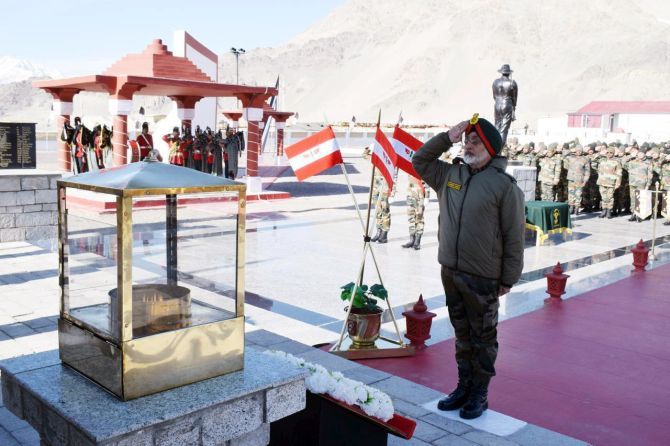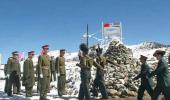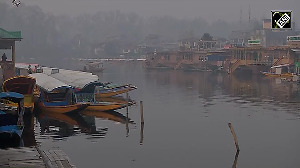Lieutenant General Harinder Singh, who commands the 'Fire and Fury' 14 Corps, has the experience and talent to face down the Chinese challenge.
The general is a rare combination of thinker and tough-minded doer, observes David Devadas.

Lieutenant General Harinder Singh has none of the booming voice, spit-and-polish starch, or puffed-out, strapping gait, that forms the stereotype of an army general.
Rather, he comes across as a reserved, soft-spoken gentleman, his head sometimes bent in thought.
His erudition and quiet charm must surely have impressed his Chinese counterpart when General Singh led an unprecedentedly high-level level round of talks on Saturday, June 6. The Chinese general is quite likely to have found his Indian interlocutor as enigmatic as a contemporary Confucius.
Of course, the talks were never likely to yield much since China appears to be operating to a script pre-planned and approved at the highest level. No wonder the government is tight-lipped about this and previous rounds of talks between army officers of the two sides.
General Singh, who commands the Fire and Fury Leh-based 14 Corps, is in the eye of the storm created by China's intrusions at various points along the Line of Actual Control between India and China in Ladakh.
He certainly has the experience and talent to face down this challenge. For he is a rare combination of a thinker who is also a tough-minded doer. Indeed, his subordinates have at times viewed him as a hard taskmaster.
Yet, he is on the surface so soft-spoken and self-effacing that one could easily mistake him for a sporty academic if one came across him in a golf cap, out for an evening walk.
He may not fit the stereotype, but General Singh has repeatedly been chosen for some of the most crucial military posts, not only in India, but as a UN commander too.
At one stage, he was reportedly considered for a posting as a military advisor in the United Nations secretary-general's office.
The general has commanded UN troops in the killing fields of Central Africa. Those who know him well say that he was deeply moved by his experience of the indescribable violence in that area of conflict. "He matured tremendously in that time," one friend remarked.
Maturity no doubt deepened his erudition. Already, while he was a colonel, he spent a couple of years at the think-tank of the defence and foreign ministries, the Institute of Defence and Strategic Analysis. One might call him a classic example of a scholar-warrior, even a soldier-diplomat.
General Singh is particularly well versed with India's potential enemies. Just before he took charge of the 14 Corps, he was the Director-General of Military Intelligence at Army Headquarters.
General Singh held charge of the crucial 28 Division in Kupwara at a most challenging time, in 2016-2017. His troops had to combat unrelenting infiltration, and the entire Kashmir Valley was in uproar for several months following the killing of militant Burhan Wani.
He had to work almost round the clock for long periods in all these postings. Indeed, almost as soon as he took over as GOC in Kupwara, the place was in flames over allegations of sexual misconduct by an army jawan.
The jawan, a local boy, had been spotted meeting his betrothed. Noticing his uniform, some locals kicked up a furore over the apparently intimate couple.
The issue was quickly taken up by those who seek opportunities to discredit the army. They played to the gallery with high-pitched allegations of sexual misconduct. Nobody bothered that the jawan was engaged to the woman -- not even when the two got married a few weeks later.
Those are the sort of details that rarely get noticed in the high-decibel war-by-narratives on Kashmir.
Kupwara was in ferment again a couple of months later, following a fiery Friday sermon by a ranking Hurriyat leader from Sopore. That was during Ramzan that year, a few weeks before the rest of the Valley erupted following Burhan Wani's killing.
General Singh not only had to handle those outbursts, but also the horrific attack at the military hospital at Drugmulla about a week after Burhan Wani was killed. The corridors of that hospital were piled high with stones after hours of an unrelenting barrage of rocks.
He was up to the challenge since he had earned the trust of several key figures in Kupwara's civil society during the time when he had commanded a unit there.
People by and large looked up to him as a fair, efficient, responsive officer who won the hearts and minds of the general populace even while he effectively combated militancy.
General Singh's immediate boss, Northern Army Commander Lieutenant General Yogesh Kumar Joshi, is very well-versed with the situation in Ladakh. General Joshi was General Singh's immediate predecessor as commander of the 14 Corps.
General Joshi is a highly respected veteran of the Kargil War. The unit of which he held command at the time performed admirably in taking back the crucial Tiger Hill from the invaders.
The invaders had a view of the key Srinagar-Leh road from near the ridge of Tiger Hill, and sought to disrupt the army's supply line to Kargil, Batalik, the Siachen Glacier, and Leh.
Ironically, the positions the Chinese invaders have now gained, on the hill over the north bank of Pangong Tso lake and in the Galwan River Valley further north, give them a similar vantage over Indian positions.
The Galwan intrusion allows the Chinese to overlook and potentially block movement on the Indian Army's new road from Darbuk to Daulat Beg Oldie, the DSDBO road to the otherwise isolated Sub-Sector North.
That sub-sector is adjacent to Aksai Chin to the east, the Siachen Glacier to the west and the strategically crucial Karakoram Pass to the northwest.
The Indian Army could potentially use it to take tanks and heavy artillery to Aksai Chin in the event of hostilities.









